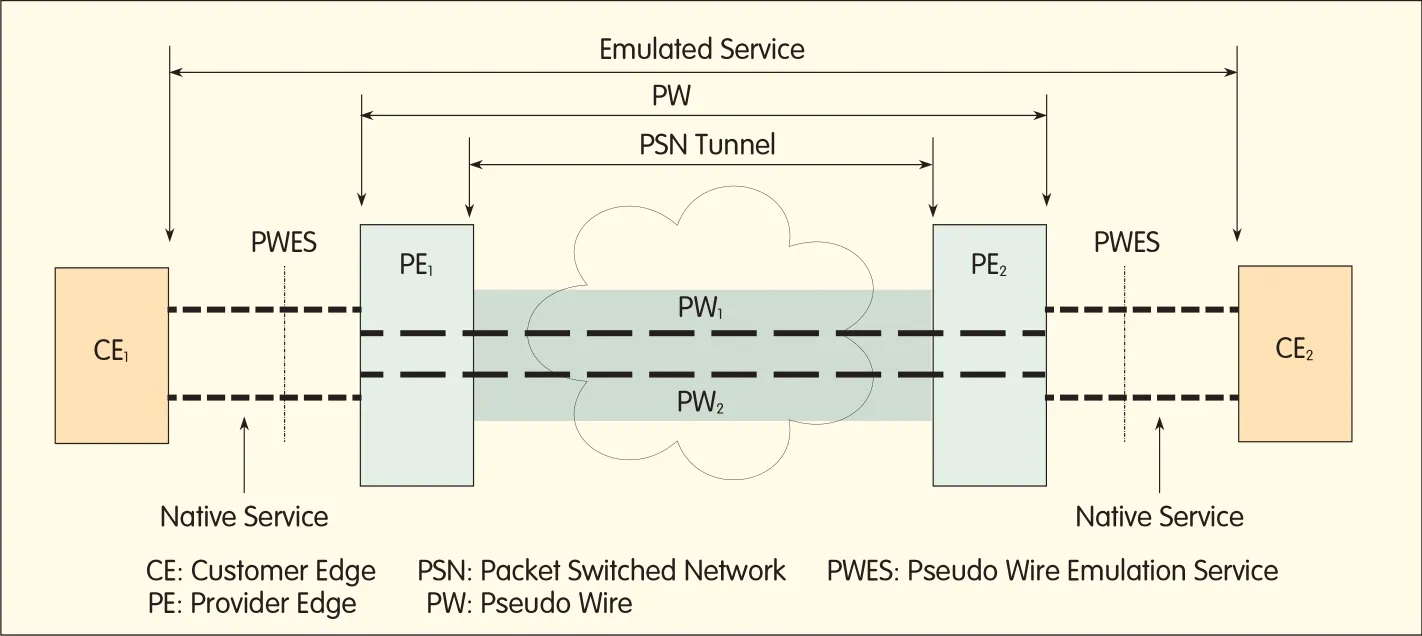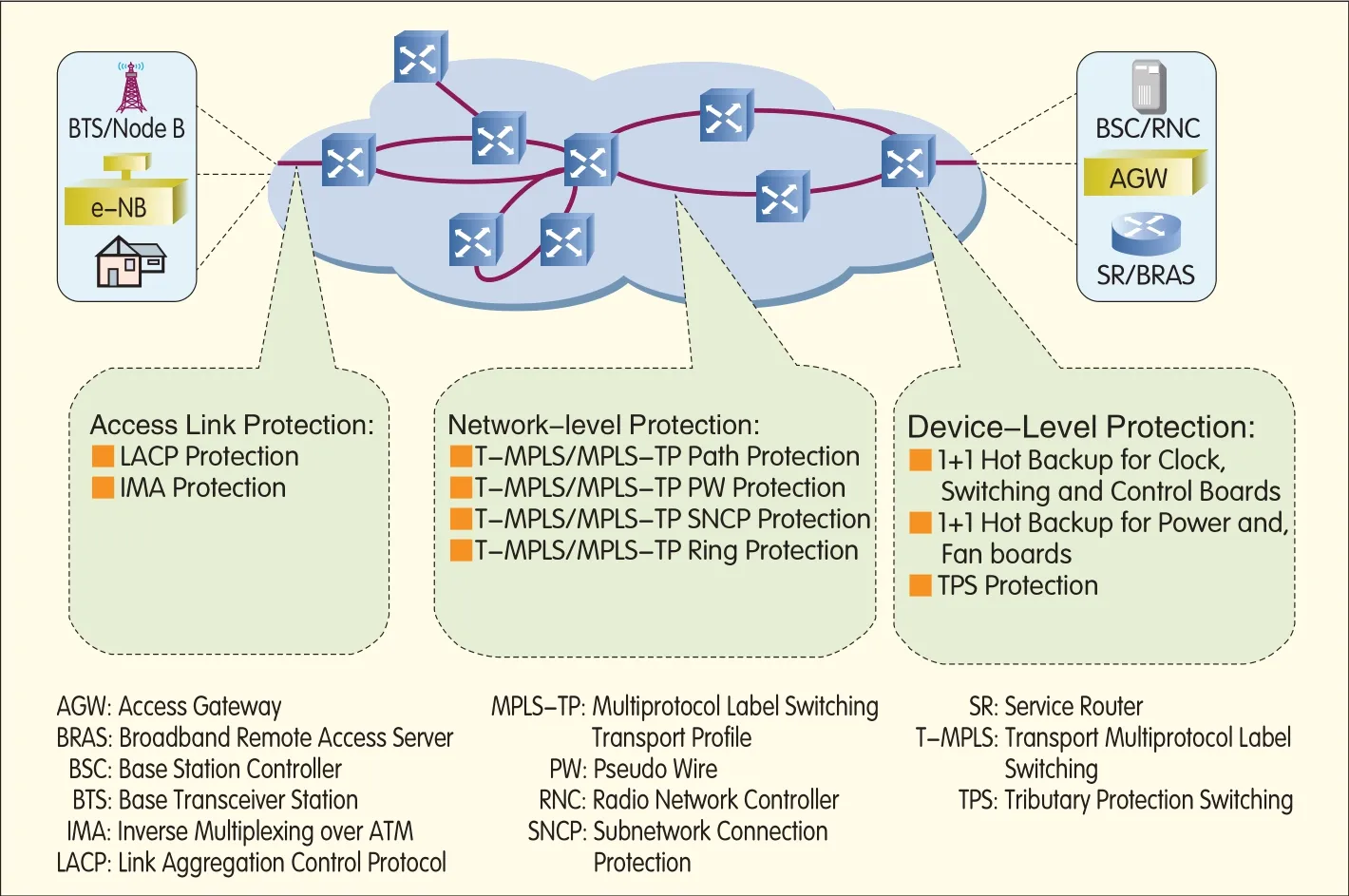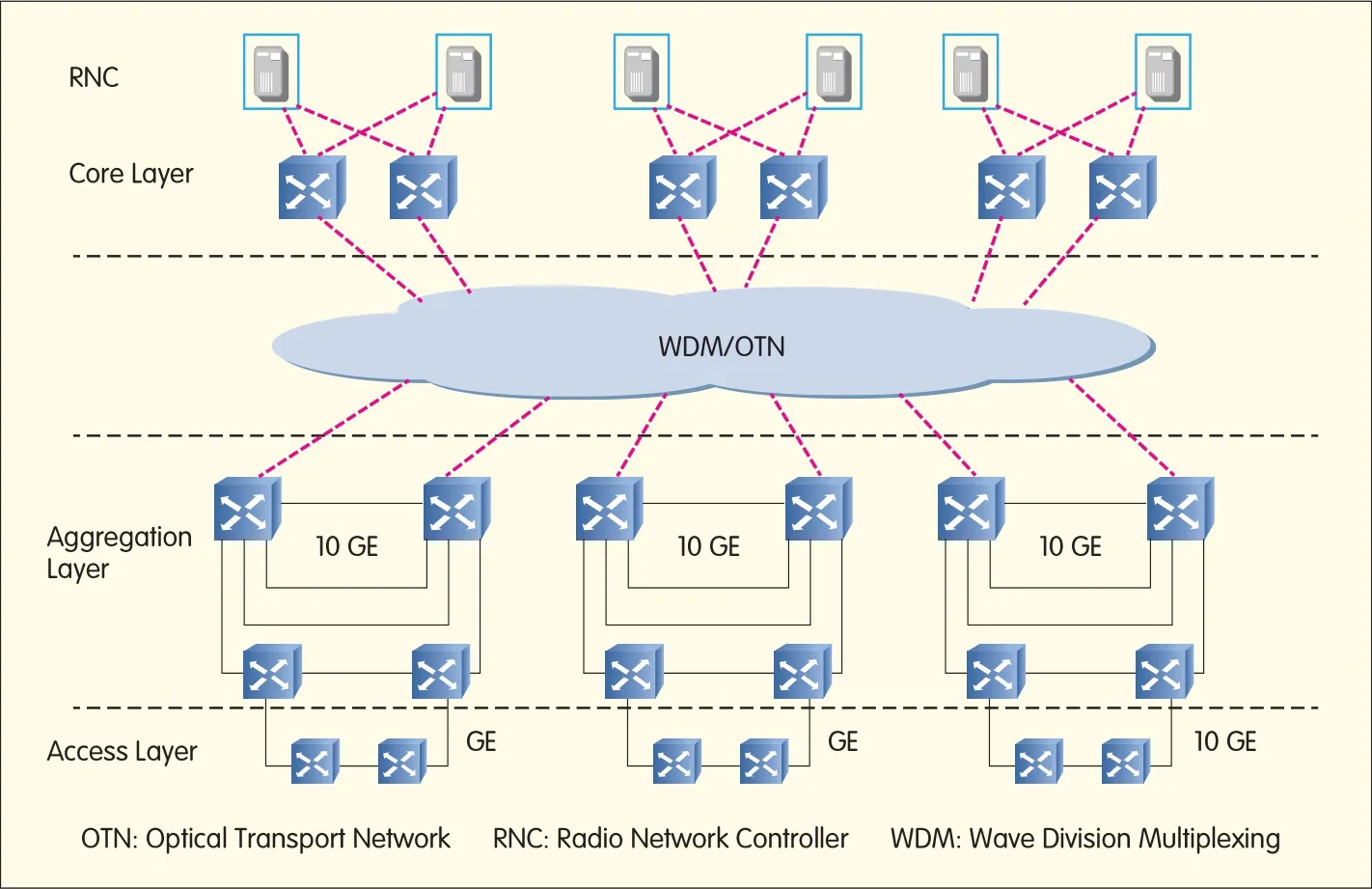PTN and IP-Based Mobile Backhaul
2010-06-05CongKaiZhaoFuchuan
Cong Kai,Zhao Fuchuan
(Bearer Network Planning&System Design Department,ZTECorporation,Shenzhen 518055,P.R.China)
Abstract:Packet Transport Networks(PTN)combine the advantages of packet technology and Synchronous Digital Hierarchy(SDH)technology.Taking the packet switch as its core,PTN has a high statistical multiplexing ability,which allows it to become a more efficient packet transfer service.Its strong Operation Administration and Maintenance(OAM)—similar to SDH and carrier-class security protection services—ensures efficient mobile backhaul business management and transmission quality.MPLSTransport Profile(MPLS-TP)packet transport network eliminates connectionless features,such as Penultimate Hop Popping(PHP),label merge and Equal-cost multi-path(ECMP),and is enhanced in terms of OAM,protection,and synchronization.This is ideally suited for carrying IP-based mobile backhaul services and key account services.PTN,original Multi-Service Transport Platform(MSTP),Metro Ethernet,and IPover Wave Division Multiplexing(WDM)/Optical Transport Network(OTN)of organic complexes,contribute to an"all IP"era of telecommunications services.
W ith the rapid development of mobile communication technologies,3G and Long Term Evolution(LTE)systems exist not just on paper,but are beginning to be deployed in reality.While the development of mobile technologies has bright prospects for the future,it also means new challenges for mobile backhaul networks.
The trend towards all-IP telecommunications services is reflected across the whole mobile communications industry.Services are being transitioned away from Time Division Multiplexing(TDM)voice to IP-based voice and data.Because IPtechnologies are being widely used in 3G networks and mobile data services continue to grow,pressure is mounting on 3G mobile backhaulnetworks for better service sensing,higher Quality of Service(QoS),and more efficient statistical multiplexing.The change of interface from E1 to FEhas also led to a sharp increase in interface bandwidth.In LTEsystems,base stations may even adopt a GE interface with a rate of 1,000 Mbit/s.
Figure 1 illustrates the evolution of mobile communication technologies.It can be seen that uplink and downlink bandwidths and rates have substantially increased during the evolution from 2G to 3G/LTE.This increase in interface rate means that much more bandwidth is required for transport networks,and transmission efficiency must be improved in order to reduce costs.

▲Figure 1.Evolution of mobile communication technologies.
In the 2G era,leading technologies of mobile backhaulnetworks included Synchronous Digital Hierarchy(SDH)and Multiservice Transport Platform(MSTP),both designed to aggregate and efficiently transmit TDM-based circuit services.In particular,MSTPwas designed to enable IPservices to be carried over transport networks.It is not,however,an all-IPsolution.Its user interface may be IP-based but at its core,it is still TDM circuit-switching and adopts a fixed tunnel for carrying packet services.As a result,MSTP suffers defects such as low transmission efficiency,high cost,and poor scalability when carrying and transmitting variable-length packets,bursty IP,and Ethernet services.In short,SDH and MSTPcannot meet the requirements of 3G/LTEsystems,and they restrain the development of mobile services.Packet Transport Network(PTN)—integrating packet technologies and SDH—is therefore introduced.

▲Figure 2.Edge-to-edge services in PTN.
1 Technical Features of PTN
3G/LTEsystems can be broadband and IP-based broadband.To accommodate these,a mobile backhaul network must have traditional capabilities such as efficient statistical multiplexing,flexible service sensing,and differentiated QoS.As a carrier-class service bearer network,it should also inherit the transmission characteristics of old systems,including end-to-end service management,hierarchical Operation,Administration and Maintenance(OAM),and carrier-class protection.PTN technology has all these capabilities.
PTN takes connection-oriented packet technologies as its core,and adopts the abovementioned transmission characteristics.As an integrated transport technology,it is used mainly to carry carrier-class Ethernet services as well as TDM and Asynchronous Transfer Mode(ATM)services.Its packet core uses bandwidth efficiently and provides flexible tunnels with powerful statistical multiplexing capability.So PTN is particularly suitable for packet services which are characterized by bursts.It inherits SDH-like transmission characteristics,powerful OAM,carrier-class protection,and Graphical User Interface(GUI)network management.As a result,users feel a sense of continuity and consistency with traditional mobile backhaul networks[1].
Two technologies are currently available for PTNs:Multiprotocol Label Switching Transport Profile(MPLS-TP)[2]and Provider Backbone Bridge Traffic Engineering(PBB-TE).MPLS-TPis an extension of core network technologies.Based on Multiprotocol Label Switching Transport(MPLS)of IP-based core networks,it simplifies the transport plane and complex control protocols.Moreover,by eliminating connectionless features,it enhances OAM and protection switching mechanisms,guarantees reliable QoS,and provides statistical multiplexing.PBB-TEis a connection-oriented transport technology and an expansion of Local Area Network(LAN)technologies.It is based on Media Access Control(MAC)-in-MAC[3]specified in IEEE 802.1ah.In PBB-TE,the MAC address self-learning function is disabled,but network management and control functions are enabled.At present,MPLS-TPis the de facto mainstream technology for PTNs.
MPLS-TPstandardization is led by the International Telecommunication Union-Telecommunication Standardization Sector(ITU-T)and the Internet Engineering Task Force(IETF).These two organizations established a Joint Working Team(JWT)in February 2008,and have made great progress in MPLS-TPstandardization.As at February 2009,the JWThad worked out five RFC documents,two recommendations,and 13 drafts.Key standards of MPLS-TPare expected to be released in 2011.
2 Key Technologies of PTN
PTN is an integrated transport network technology featuring both packet and transmission.It has become a mainstream solution for IP-based mobile backhaulnetworks in 3G/LTE systems due to several key technologies.
2.1 Pseudo Wire Emulation Edge-to-Edge(PWE3)
3G systems are developing at pace but traditional TDM services will continue to be the main source of profit for telecom operators for some time.Therefore,PTN should be capable of carrying multiple services.PWE3 is designed specifically for this purpose.By using PWE3 circuit emulation,MPLS-TPadapts itself to all types of customer services—including Ethernet,TDM,and ATM—and provides dedicated edge-to-edge tunnels for these services.
PWE3 is a service emulation mechanism which encapsulates service data in a special circuit emulation header.This header includes the basic attributes of service data such as frame format,alarm,signaling,and synchronous timing[4].Edge-to-edge services in the PTN are illustrated in Figure 2.In PWE3,a Pseudo Wire(PW)is set up and maintained in a Packet Switched Network(PSN)tunnel.A Provider Edge(PE)uses the PWto encapsulate service data for transmission,keeping the attributes and features of the service as much as possible.For a Customer Edge(CE),the PWis merely a link or circuit occupied exclusively by a specific service.This circuit is called virtual circuit.The CEdoes not recognize the existence of the core network and treats allservices it processes as native services.

▲Figure 3.OAMpacketencapsulation formats specified in ITU-TG.8114.
2.2 QoS
In a SDH-based mobile backhaul network,an exclusive rigid tunnel is provided for all services.This transmission mode is highly reliable,but on the other hand leads to transmission waste because services may have different characteristics.Voice services,for example,with high real-time characteristics,have different transmission requirements to common Internet services.PTN can sense service characteristics and provide transmission as required.For telecom operators,offering suitable transmission for different service flow is cost-efficient,especially when the demand for bandwidth increases substantially.
2.3 Hierarchical OAM and Carrier-Class Protection
The OAM mechanism of PTN basically derives from SDH,and provides alarm and performance management for the section layer,Label Switched Path(LSP)layer,and Pseudo Wire(PW)layer.By supporting hierarchical OAM,this mechanism can quickly locate a PTN fault,and detect network performance issues such as packet loss rate and delay[5].
ITU-Tspecifies the OAM packet encapsulation formats[6]for Transport Multiprotocol Label Switching(T-MPLS),as shown in Figure 3.The OAM signaling packets of each layer also contain labels encapsulated with MPLS.To distinguish OAM signaling packets from users’service data packets,a special label(14)is defined.By defining a series of OAM protocol packets,G.8114 implements diverse OAM functions.
PTN’s all-round carrier-class protection is illustrated in Figure 4.PTN provides access link protection,network-level protection,and device-level protection.It also supports ring,linear,and mesh protection modes.Each mode has its own merits and shortcomings,suitable for different scenarios.Ring protection can provide a high levelof protection specifically for ring topology[7],while linear protection is not specific to any topology and can be implemented with two connections for each path in a fixed network.In application,these modes are often used in combination in order to achieve carrier-class service protection.
OAM and protection are closely related to each other.Using the OAM mechanism to achieve timely fault detection is a premise for carrier-class protection.There are three types of OAM related to the PTN protection mechanism:alarm-related,performance-related,and communication channel-related.
2.4 Synchronization
The development of mobile communication technologies also has implications for time synchronization in mobile backhaulnetworks.ITU-T,IEEE,and other standardization organizations have proposed numerous time synchronization solutions.Among them,the most attractive is precision clock synchronization protocol suggested in the IEEE 1588v2 standard[8].This protocol adopts a master/slave clock configuration and encodes the time before transmission.Taking advantage of the symmetry of network links and delay measurement technology,it synchronizes frequency,phase,and the absolute time of master and slave clocks.

▲Figure 4.All-around carrier-class protection of PTN.
ZTEhas been the first to adopt IEEE 1588v2 Precision Time Protocolfor clock synchronization based on synchronous Ethernet[9].The core idea of this solution is to set up a network with separate but highly controllable clock time in order to avoid unpredictable risks.With synchronous Ethernet at the physical layer,frequency synchronization is implemented among nodes,thus controlling the nodes’phases within a certain range and guaranteeing accurate frequency.IEEE 1588 protocol is only used for phase tuning and time transfer.Aclock dedicated network constructed in this way is connection-oriented,strictly controllable,and point-to-point.It avoids interference from asymmetrical IEEE 1588 systems during deployment,and its time synchronization performance is independent of network loader traffic.
3 Relationship between PTN and Other Bearer Networks
3.1 PTN vs.MSTP Netowrk
In the 2G era,SDH/MSTP-based networks provided stable and reliable transmission for mobile services and were widely applied in mobile networks.In 3G/LTEsystems where PTN has been introduced,the issue arises of handling the relationship between PTN and the existing MSTPnetwork.Taking into account network complexity,construction expenses,and operation and maintenance costs,an independent PTN plane is able to be set up in addition to the existing MSTP plane.
Although this requires a large investment in the early stages of PTN construction,the advantages are significant.First,existing 2G services can be carried by the MSTPnetwork without being affected during 3G construction.Second,3G services can develop smoothly,bandwidth demand of future data services can be easily satisfied,and mobile networks can evolve gracefully to LTE.This solution provides a clear structure of the mobile backhaul network,greatly facilitating future planning,management,and maintenance of the network.
Depending on the availability of MSTPresources in the existing network,a networking mode comprising a mixture of PTN and MSTPcan be adopted in some areas of the network as a supplement to the above solution.That is to say,PTN devices can be introduced into the network access layer or aggregation layer of existing MSTPnetwork where there is bandwidth shortage.This not only implements cross-area resource dispatching,but also enables the operator to accumulate experience in low cost PTN planning,operation,maintenance,and management.
In short,2G networks will continue to be highly profitable for operators for quite some time.This means that MSTP PTN must co-exist.However,in the long term,after allmobile communication networks have become IP-based,MSTPwill inevitably be replaced by PTN[10].It may even supplement PTN in providing dedicated access for customers who demand small bandwidth but high security and privacy,or by covering regions temporarily out of reach of PTN.
3.2 PTN vs.WDM/OTN
IPover Wave Division Multiplexing(WDM)/Optical Transport Network(OTN)implements flexible dispatching and protection of large-granule services based on wavelength or Optical Cannel Data Unit(ODU).When constructing a Metropolitan Area Network(MAN),IPover WDM/OTN can be applied in the core layer,providing networking,dispatching and protection of large-granule services of core network elements.If a large MAN is used to carry mobile backhaulservices,PTN+WDM/OTN networking mode can be used.In this mode,the access/aggregation layer is networked in the form of PTN—which dispatches services upwards to the PTN core dispatching layer in the Radio Network Controller(RNC)equipment room via IP over WDM/OTN.This greatly simplifies the network that contains core layer nodes and aggregation layer backbone nodes,and flexibly dispatches services during adjustment of service homing.

▲Figure 5.Flexible networking of PTNservices with WDM/OTN.
Moreover,as the core layer nodes are only connected to the RNC equipment room,the problem is avoided whereby all node devices must be upgraded because one node has been upgraded to expand its service capacity(a problem sometimes encountered in pure PTN networks).Network costs are therefore saved.WDM/OTN provides flexible dispatching and networking for PTN services,as shown in Figure 5.
3.3 PTN vs.Metro Ethernet
In constructing a MAN,and depending on the nature of services carried on the network,an independent approach is often adopted.Two planes are constructed:a high-value mobile backhaul network and a low-value broadband access network.PTNis primarily used for carrying high value services such as mobile backhaul and services for important group customers.Low-value services such as public broadband access and services for large customers are first carried over a Passive Optical Network(PON),and are then sent to the service control layer,Broadband Remote Access Server(BRAS)or Service Router(SR)through a metro Ethernet.The two planes work independently and do not interfere with each other.Such a strategy takes the following into consideration:
(1)Important services such as Internet services and mobile backhaul services differ in configurability and have different reliability requirements.A shared plane that carries all these services creates greater network complexity.Moreover,Internet services require much more bandwidth than mobile backhaulservices.If they share the same plane,MAN access devices must be re-configured for large capacity,high reliability technologies,and this increases costs.
(2)Broadband services are subject to frequent change.So sharing the same plane with mobile backhaul services may affect the stability of mobile services.If the stability of mobile services is to be guaranteed,demand for broadband services cannot be quickly accomodated.Stability and quick response to service demands cannot be realized at the same time.
(3)Internet services are open.If they share the same plane as mobile backhaul services,the network may become vulnerable.
4 Application of ZTE’s PTN Products
With strength in research and development,and with significant investment,ZTEnow provides a full range of high-performance PTN products.In bidding tests conducted by China Mobile in 2009,ZTE’s products ranked first.Moreover,ZTE has deployed its PTN products in systems of several multinational operators including Telefonica,Telenor,and TIM.
In the second quarter of 2009,China Mobile conducted performance tests on PTN products and IP-based Iub interfaces of several vendors.These tests were conducted in its telecom network in Shenzhen and were designed to evaluate PTN products in terms of multi-service bearing capability,QoS,OAM,time synchronization,and longevity.When ZTE’s PTN products were used to carry services via IP-based Iub interfaces,service indexes and transmission quality met requirements.Compared with MSTPproducts,ZTE’s PTN even excelled MSTPin some indexes and satisfied the TD service requirements of China Mobile.
To date,ZTE’s PTN products have been used in China Mobile’s PTN network construction in over 20 provinces.
5 Conclusions
Service requirements are the driving force behind the development of PTN technologies.In the evolution to 3G,High Speed Packet Access Plus(HSPA+),and LTEnetworks,traditional mobile services must become IP-based because emerging mobile services impose greater requirements on synchronization,network delay,reliability,and security.PTN is introduced in this context.As the industrial chain matures,PTN will advance technologically,have greater cost benefits,and will eventually become the mainstream carrier platform for high value services such as mobile backhaul.The introduction and development of PTN will,in turn,drive the development of service networks and promote the rapid growth of IP-based services.
杂志排行
ZTE Communications的其它文章
- Standardization Progress of Packet Transport Networks
- Several Issues in the Development of Packet Transport Networks
- Features of PBB-TEArchitecture and GMPLSControl Technology
- Ring Protection and Survivability Mechanisms for Packet Transport Networks
- Service Adaptation and Label Forwarding Mechanism for MPLS-TP
- PTN Clock Synchronization Technology and Its Applications
